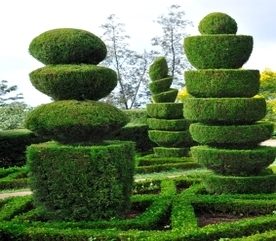How to Space and Plant Freestanding Shrubs
Shrubs are supplied by nurseries in three forms: container grown, with balled roots, or with bare roots. Read on to find out more on spacing and planting your freestanding shrubs.

Container shrubs are established plants growing in pots of soil or soil substitute. They can be planted outdoors at any time of year except in the dead of winter. If you plant in summer, keep the soil well watered until autumn. Newly planted shrubs may die if the soil dries out.
Balled-root shrubs have some soil around the roots, kept in place by burlap. Plants that have difficulty establishing themselves are sold this way to keep the root systems intact. Shrubs that can develop easily after transplanting are often sold with bare roots.
Bare-root and balled-root shrubs are best planted in autumn or early winter after dormancy has set in but before the ground is frozen, or early in the spring. Evergreens can be set out earlier in the fall or later in the spring than can deciduous shrubs.
First, you must prepare the soil. Remove perennial weeds from the bed with a garden fork. Dig over the soil to one spade’s depth, and if possible, let it settle for about two weeks. If you must plant immediately, firm the whole bed thoroughly by treading it down.
How to Plant Shrubs
If you are planting more than one shrub, work out the spacing beforehand and mark the planting positions. The space between shrubs should be at least half the total of their combined ultimate spread. For example, two shrubs expected to spread 4 feet and 6 feet, respectively, should be planted about 5 feet apart.
Remove the marker. Dig a hole as deep and slightly wider than the shrub’s container or root ball. If the plant is bare rooted, allow room for its roots to spread comfortably. Measure for depth against the plant itself.
If working with a container-grown shrub, the surface of the soil in the pot should be level with the surrounding soil. With balled- or bare-root shrubs, use the mark on the stem that indicates the former soil level. Do not remove the burlap around a balled-root shrub.
Mix the soil from the hole with well-rotted compost, manure, or peat moss-2 parts of the soil to 1 part of the organic material. Break up the soil at the bottom of the hole. Trim the top growth of the shrub as illustrated below.
If the shrub is container grown, water it well before removing the container. Make sure that the plant has an extensive root system. If it does not, return it to the nursery.
If your shrub is bare rooted, look for damaged or diseased roots and cut them back to healthy growth. Before putting the plant in the hole, make a small mound on the bottom over which to spread the roots.
When you set the shrub in the hole, hold it firmly by the base of the stem in order to keep it vertical while you fill in the hole with the prepared soil. With a container-grown or balled-root shrub, fill the hole about halfway-balled-root plants should have the burlap untied and laid back across the hole at this point-then water thoroughly and let the water drain before adding more soil. Tread the soil firmly. Top with more soil, tread again, and build a small wall of soil around the hole to retain water. Then soak well all around the base of the plant.
With a bare-root shrub, lift the plant up and down as you fill the hole, gently shaking the roots so that the soil will settle around them. Firm the soil with your feet several times to eliminate air pockets.



